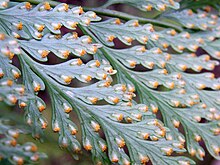
Davallia is a genus of about 40 species of fern. In the Pteridophyte Phylogeny Group classification of 2016, it is the only genus in the family Davalliaceae, which is placed in the suborder Polypodiineae, order Polypodiales. Alternatively, the family may be placed in a very broadly defined family Polypodiaceae sensu lato as the subfamily Davallioideae.

Psilotum nudum, the whisk fern, is a fernlike plant. Like the other species in the order Psilotales, it lacks roots.

Pteris vittata, commonly known variously as the Chinese brake, Chinese ladder brake, or simply ladder brake, is a fern species in the Pteridoideae subfamily of the Pteridaceae. It is indigenous to Asia, southern Europe, tropical Africa and Australia. The type specimen was collected in China by Pehr Osbeck.

Asplenium australasicum, the bird's nest fern or crow's nest fern, is an epiphytic Australasian species of fern in the family Aspleniaceae.
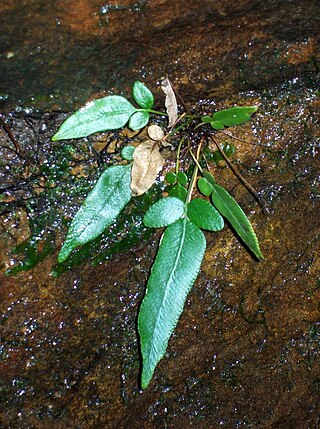
Parablechnum ambiguum, synonym Blechnum ambiguum, is a species of fern in the family Blechnaceae. growing on wet rocks in eastern Australia, often seen near waterfalls. It is common around Sydney.
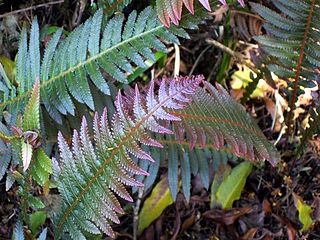
Doodia aspera, commonly known as prickly rasp fern, is a widespread and common plant, growing in eastern Australia. Often seen in rainforest margins or eucalyptus forest in Victoria, New South Wales and Queensland, it is a terrestrial fern with reddish new growth.

Calochlaena dubia, commonly known as soft bracken, false bracken, common ground fern or rainbow fern, is a small Australian fern in the treefern family Dicksoniaceae. It is very common within its range, and often seen growing under eucalyptus forest, often on the poorer quality soils. It is an easy plant to grow in the garden.
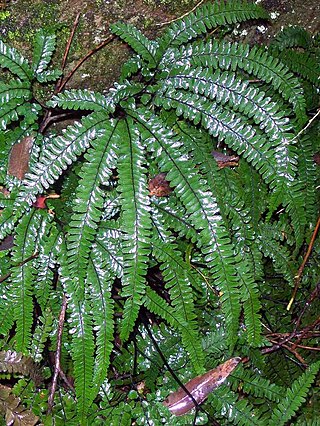
Adiantum hispidulum, commonly known as rough maidenhair fern or five-fingered jack, is a small fern in the family Pteridaceae of widespread distribution. It is found in Africa, Australia, Polynesia, Malesia, New Zealand and other Pacific Islands. Its fronds rise in clumps from rhizomes among rocks or in the soil in sheltered areas.
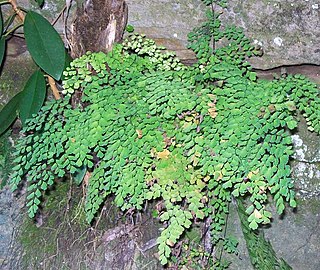
Adiantum aethiopicum, also known as the common maidenhair fern, is a small fern of widespread distribution, occurring in Africa, Australia, Norfolk Island and New Zealand.

Cheilanthes distans is a species of lip fern known by the common name bristly cloak fern. It has a woolly appearance with small white hairs on the top side of the fronds, and a rusty brown underneath.

Sticherus lobatus, known as the spreading fan fern, is a small fern found in eastern and southern Australia. It is a common and attractive plant, similar to S. flabellatus but with additional lobed segments. It often forms colonies in open forest areas or on the edge of rainforests.

Astrotricha latifolia, known as the broad-leaf star hair, is a plant found in eastern Australia. A shrub usually seen around 3 metres tall. Though it can grow to 9 metres tall and be an imposing small tree in the eucalyptus understorey.
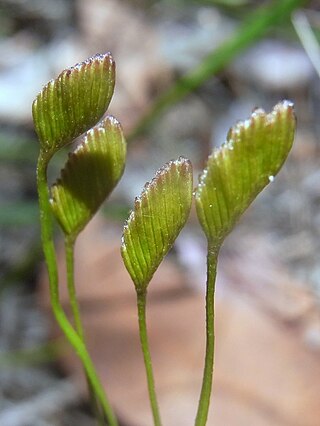
Schizaea bifida, the forked comb fern is a fairly common fern found in eastern and southern Australia. Also seen in New Zealand and New Caledonia. In New South Wales it is found near the coast in heathland and eucalyptus woodland. Seen as a low plant, 10 to 35 cm tall. The generic name Schizaea is from the Greek, meaning “to cleave or split”. Bifida means split in two.
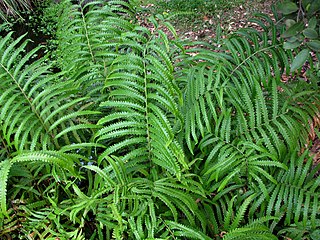
Cyclosorus interruptus, the Hottentot fern or swamp shield-fern, is a fern in the family Thelypteridaceae. It is native to the tropics and subtropics in many parts of the world. In the New World, it is found from Mexico to Argentina, and in the Antilles. In the Old World, it is found in India, China, Malaysia, Sri Lanka and South Africa. It is also found in Australia, New Zealand, Hawaii and other islands in the Pacific Ocean. The various populations differ with respect to genetic cytotypes, glands, pubescence, and frond size. Its habitat is the vicinity of freshwater swamps and it may reach 1 m in height.

Telmatoblechnum indicum or the swamp water fern is often seen growing on sandy soils in swampy areas. The specific epithet indicum is from Latin, revealing this plant was first collected in the East Indies (Java). Indigenous Australians used the starchy rhizome as food.

Hypolepis muelleri known as the ground fern or harsh ground fern is a common small fern found in swampy areas and beside streams in eastern Australia. Usually seen between 30 and 100 cm tall with an erect habit. Despite the common name, the fronds are soft to touch. This plant was named in honour of the colonial botanist Ferdinand von Mueller. The original specimen was collected from Alfred National Park in 1941.
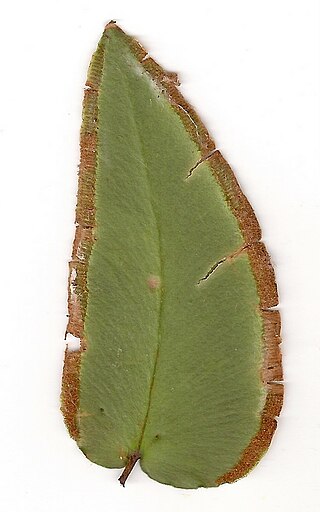
Pellaea paradoxa is a small hardy fern found north of Sydney in eastern Australia and Lord Howe Island. Often growing in or near rainforests in rocky crevices. But it may occasionally be seen in drier areas. Fronds are usually curved, 4 to 9 cm long, and 1 to 4 cm wide. Leathery to touch and a dull green. Juvenile fronds may be heart shaped. The stalks are around 1 to 5 mm long. Sori appear in a band, usually 2 to 3 mm wide, at the edge of the underside of the fronds.

Micrantheum ericoides is an inconspicuous shrub growing on poor sandy soils in eastern Australia. Often seen in areas of mid to relatively high rainfall. Usually seen between 20 and 80 cm high. Flowers are tiny, white or pink occurring between August and November. However, the plant may be noticed by the red fruit capsules.
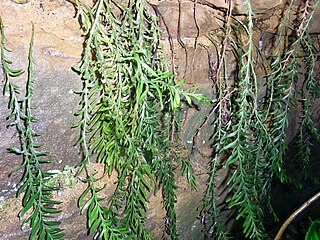
Tmesipteris truncata is a fern ally endemic to eastern Australia. The habitat of this primitive plant is under waterfalls, or in sandstone gullies or rainforests. Commonly referred to as a Fork Fern. It is often found growing on the base of the King Fern. Usually seen as an epiphyte or lithophyte, but it may also appear as a terrestrial plant. Found as far south as Mount Dromedary.

Schizaea rupestris is a small Australian fern. Most populations are in found in the ranges near Sydney. However, it also occurs near Woolgoolga and Western Australia.
